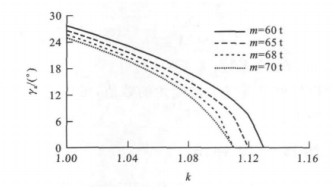Safety analysis of aircraft encountering wake vortex
-
摘要: 分析了飞机遭遇尾涡后的响应机理, 建立了飞机受扰诱导力矩计算模型; 综合考虑飞机阻尼特性、反应时间以及操纵品质等因素, 建立了飞机滚转参数计算模型; 以抖动失速作为飞机遭遇尾涡后改出过程的坡度角极限, 建立了可接受最大坡度角计算模型。采用Delphi7.0计算了给定尾涡流场条件下的飞机受扰后滚转参数和尾涡安全间隔, 分析了飞机质量、速度、高度容差以及初始坡度角对飞行安全的影响。分析结果表明: 在速度一定时, 飞机质量越大, 可接受最大坡度角越小; 在相同质量情况下, 安全间隔随速度增加而缓慢减小, 随高度容差的减小而减小, 随初始坡度角增大而增大; 安全间隔计算结果与国际民用航空组织(ICAO)标准数据之间的最大偏差是1.56%, 因此, 计算方法正确。Abstract: The response mechanism of aircraft encountering wake vortex was analyzed, and the calculation model of induced moment was developed. The calculating model of aircraft's rolling parameters was constructed based on considering of the damping characteristics of aircraft, the response times, the handling qualities and so on. The calculation model of the accepted maximum bank angle was constructed based on the assumption that the buffet stall speed was posed as a critical limit in calculating the rolling progress. The rolling parameters and safe intervals of wake vortex under certain wake vortex's field condition were calculated by using DelphiT. 0. The influences of aircraft mass, speed, altitude tolerance and initial bank angle on flight safety were analyzed. Research result shows that at a certain speed, the greater aircraft mass is, the smaller the accepted maximum bank angle is. The safe interval of aircraft with certain mass decreases with the increase of speed and the decrease of altitude tolerance, while it increases with the increase of initial bank angle. Comparing the data calculated by the models with ICAO standard data, the maximal deviation is 1.56%, which verifies the correctness of the computation method.
-
Key words:
- flight safety /
- wake vortex /
- stall speed /
- wake vortex field /
- rolling bank angle
-
表 1 回转半径
Table 1. Gyration radii

表 2 安全间隔对比
Table 2. Comparison of safe intervals

-
[1] 魏志强, 徐肖豪. 飞机尾涡流场的建模与仿真计算研究[J]. 交通运输系统工程与信息, 2010, 10 (4): 186-191. doi: 10.3969/j.issn.1009-6744.2010.04.029WEI Zhi-qiang, XU Xiao-hao. Modeling and simulating of flow field for aircraft wake vortex[J]. Journal of Transportation Systems Engineering and Information Technology, 2010, 10 (4): 186-191. (in Chinese) doi: 10.3969/j.issn.1009-6744.2010.04.029 [2] VICROY D D, VIJGEN P M, REIMER H M, et al. Recent NASA wake-vortex flight tests, flow-physics database and wake-development analysis[C]//AIAA. World Aviation Congress and Exposition. Anaheim: AIAA, 1998: 1-14. [3] LIOT D. Wake vortex encounter model implementation and validation in the online (piloted) flight simulation environment[R]. Toulouse: WAVENC Technical Note TN-19, AM Airbus, 2000. [4] DE BRUIN A C, SPEIJKER L J P, MOET H, et al. S-wake: assessment of wake vortex safety[R]. Amsterdam: National Aerospace Laboratory NLR, 2003. [5] LUCKNER R, HÖHNE G, FUHRMANN M. Hazard criteria for wake vortex encounters during approach[J]. Aerospace Science and Technology, 2004, 8 (8): 673-687. [6] BRANDON J M, JORDAN F L, STUEVER R A, et al. Application of wind tunnel free-flight technique for wake vortex encounters[R]. Washington DC: NASA, 1997. [7] PADFIELD G D, MANIMALA B, TURNER G P. A severity analysis for rotorcraft encounters with vortex wakes[J]. Journal of the American Helicopter Society, 2004, 49 (4): 445-456. [8] LAWRENCE B, PADFIELD G D. Wake vortex encounter severity for rotorcraft in approach and landing[R]. Florence: 31st European Rotorcraft Forum, 2005. [9] 胡军, 徐肖豪. 空中交通中尾流间隔的研究[J]. 中国民航学院学报, 2002, 20 (4): 1-5. doi: 10.3969/j.issn.1001-5590.2002.04.001HU Jun, XU Xiao-hao. Wake vortex separation of ATC[J]. Journal of Civil Aviation University of China, 2002, 20 (4): 1-5. (in Chinese) doi: 10.3969/j.issn.1001-5590.2002.04.001 [10] 冯志勇. 尾流对飞行的影响及安全间隔研究[D]. 成都: 西南交通大学, 2007.FENG Zhi-yong. How wake vortexes affect the flights and safety separation research[D]. Chengdu: Southwest Jiaotong University, 2007. (in Chinese) [11] 徐肖豪, 赵鸿盛, 杨传森, 等. 飞行进近中尾流的大涡数值模拟[J]. 南京航空航天大学学报, 2010, 42 (2): 179-184. doi: 10.3969/j.issn.1005-2615.2010.02.010XU Xiao-hao, ZHAO Hong-sheng, YANG Chuan-sen, et al. Large eddy simulation of wake vortex during approach[J]. Journal of Nanjing University of Aeronautics and Astronautics, 2010, 42 (2): 179-184. (in Chinese) doi: 10.3969/j.issn.1005-2615.2010.02.010 [12] 徐肖豪, 赵鸿盛, 王振宇. 尾流间隔缩减技术综述[J]. 航空学报, 2010, 31 (4): 655-662.XU Xiao-hao, ZHAO Hong-sheng, WANG Zhen-yu. Overview of wake vortex separation reduction systems[J]. Acta Aeronautica et Astronautica Sinica, 2010, 31 (4): 655-662. (in Chinese) [13] POIREL D, PRICE S J. Bifurcation characteristics of a twodimensional structurally non-linear airfoil in turbulent flow[J]. Nonlinear Dynamics, 2007, 48 (4): 423-435. [14] BROWN A. The impact upon aircraft airworthiness design from encounters with discrete vortices[C]//AIAA. 44th AIAA Aerospace Sciences Meeting and Exhibit. Reno: AIAA, 2006: 1-19. [15] CROW S C. Stability theory for a pair of trailing vortices[J]. AIAA Journal, 1970, 8 (12): 2172-2179. -





 下载:
下载:






